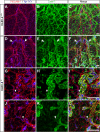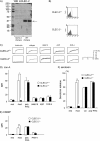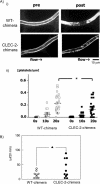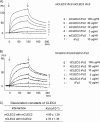Essential in vivo roles of the C-type lectin receptor CLEC-2: embryonic/neonatal lethality of CLEC-2-deficient mice by blood/lymphatic misconnections and impaired thrombus formation of CLEC-2-deficient platelets
- PMID: 20525685
- PMCID: PMC2915686
- DOI: 10.1074/jbc.M110.130575
Essential in vivo roles of the C-type lectin receptor CLEC-2: embryonic/neonatal lethality of CLEC-2-deficient mice by blood/lymphatic misconnections and impaired thrombus formation of CLEC-2-deficient platelets
Abstract
CLEC-2 has been described recently as playing crucial roles in thrombosis/hemostasis, tumor metastasis, and lymphangiogenesis. The snake venom rhodocytin is known as a strong platelet activator, and we have shown that this effect is mediated by CLEC-2 (Suzuki-Inoue, K., Fuller, G. L., García, A., Eble, J. A., Pöhlmann, S., Inoue, O., Gartner, T. K., Hughan, S. C., Pearce, A. C., Laing, G. D., Theakston, R. D., Schweighoffer, E., Zitzmann, N., Morita, T., Tybulewicz, V. L., Ozaki, Y., and Watson, S. P. (2006) Blood 107, 542-549). Podoplanin, which is expressed on the surface of tumor cells, is an endogenous ligand for CLEC-2 and facilitates tumor metastasis by inducing platelet aggregation. Mice deficient in podoplanin, which is also expressed on the surface of lymphatic endothelial cells, show abnormal patterns of lymphatic vessel formation. In this study, we report on the generation and phenotype of CLEC-2-deficient mice. These mice are lethal at the embryonic/neonatal stages associated with disorganized and blood-filled lymphatic vessels and severe edema. Moreover, by transplantation of fetal liver cells from Clec-2(-/-) or Clec-2(+/+) embryos, we were able to demonstrate that CLEC-2 is involved in thrombus stabilization in vitro and in vivo, possibly through homophilic interactions without apparent increase in bleeding tendency. We propose that CLEC-2 could be an ideal novel target protein for an anti-platelet drug, which inhibits pathological thrombus formation but not physiological hemostasis.
Figures









Similar articles
-
Involvement of the snake toxin receptor CLEC-2, in podoplanin-mediated platelet activation, by cancer cells.J Biol Chem. 2007 Sep 7;282(36):25993-6001. doi: 10.1074/jbc.M702327200. Epub 2007 Jul 6. J Biol Chem. 2007. PMID: 17616532 Clinical Trial.
-
[Identification of the novel platelet activation receptor CLEC-2 and Its pathological and physiological roles].Rinsho Byori. 2010 Dec;58(12):1193-202. Rinsho Byori. 2010. PMID: 21348239 Review. Japanese.
-
Essential in vivo roles of the platelet activation receptor CLEC-2 in tumour metastasis, lymphangiogenesis and thrombus formation.J Biochem. 2011 Aug;150(2):127-32. doi: 10.1093/jb/mvr079. Epub 2011 Jun 21. J Biochem. 2011. PMID: 21693546 Review.
-
Platelet activation receptor CLEC-2 regulates blood/lymphatic vessel separation by inhibiting proliferation, migration, and tube formation of lymphatic endothelial cells.J Biol Chem. 2012 Jun 22;287(26):22241-52. doi: 10.1074/jbc.M111.329987. Epub 2012 May 3. J Biol Chem. 2012. PMID: 22556408 Free PMC article.
-
Platelet CLEC-2: Roles Beyond Hemostasis.Semin Thromb Hemost. 2018 Mar;44(2):126-134. doi: 10.1055/s-0037-1604090. Epub 2017 Oct 9. Semin Thromb Hemost. 2018. PMID: 28992650 Review.
Cited by
-
Combined in vivo depletion of glycoprotein VI and C-type lectin-like receptor 2 severely compromises hemostasis and abrogates arterial thrombosis in mice.Arterioscler Thromb Vasc Biol. 2013 May;33(5):926-34. doi: 10.1161/ATVBAHA.112.300672. Epub 2013 Feb 28. Arterioscler Thromb Vasc Biol. 2013. PMID: 23448972 Free PMC article.
-
Advances in fluorescence microscopy techniques to study kidney function.Nat Rev Nephrol. 2021 Feb;17(2):128-144. doi: 10.1038/s41581-020-00337-8. Epub 2020 Sep 18. Nat Rev Nephrol. 2021. PMID: 32948857 Review.
-
Extracellular Vesicles Are Important Mediators That Regulate Tumor Lymph Node Metastasis via the Immune System.Int J Mol Sci. 2023 Jan 10;24(2):1362. doi: 10.3390/ijms24021362. Int J Mol Sci. 2023. PMID: 36674900 Free PMC article. Review.
-
Elevated soluble platelet glycoprotein VI is a useful marker for DVT in postoperative patients treated with edoxaban.Int J Hematol. 2014 Nov;100(5):450-6. doi: 10.1007/s12185-014-1676-x. Epub 2014 Sep 25. Int J Hematol. 2014. PMID: 25253166
-
Inhibition of SARS-CoV-2-mediated thromboinflammation by CLEC2.Fc.EMBO Mol Med. 2023 Jul 10;15(7):e16351. doi: 10.15252/emmm.202216351. Epub 2023 May 22. EMBO Mol Med. 2023. PMID: 37211986 Free PMC article.
References
-
- Cambi A., Figdor C. G. (2003) Curr. Opin. Cell Biol. 15, 539–546 - PubMed
-
- Marshall A. S., Gordon S. (2004) Eur. J. Immunol. 34, 18–24 - PubMed
-
- Suzuki-Inoue K., Fuller G. L., García A., Eble J. A., Pöhlmann S., Inoue O., Gartner T. K., Hughan S. C., Pearce A. C., Laing G. D., Theakston R. D., Schweighoffer E., Zitzmann N., Morita T., Tybulewicz V. L., Ozaki Y., Watson S. P. (2006) Blood 107, 542–549 - PubMed
-
- Suzuki-Inoue K., Kato Y., Inoue O., Kaneko M. K., Mishima K., Yatomi Y., Yamazaki Y., Narimatsu H., Ozaki Y. (2007) J. Biol. Chem. 282, 25993–26001 - PubMed
Publication types
MeSH terms
Substances
LinkOut - more resources
Full Text Sources
Other Literature Sources
Medical
Molecular Biology Databases

